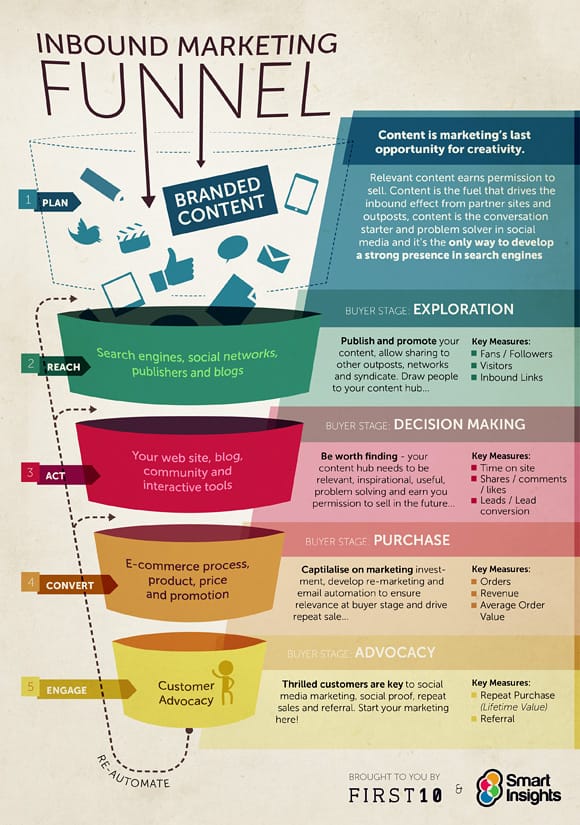How Content Marketing Fits into Your Buying Cycle
To attract the best prospects, generate the most leads, and convert the most buyers, it pays to have a well-planned buying cycle or sales funnel for each buyer persona. That way you know where your sales are coming from and how to appeal to each type of customer.
So where does content marketing fit into the buying cycle?
The answer: everywhere. When your content is aligned with your sales funnel, it becomes much more effective at guiding prospects through the cycle.
More content offers more opportunities to help prospects come to know, like, trust, and buy from you. And the longer or more complex your buying cycle is, the more content you need to help prospects get through it.
Most marketing experts divide the sales funnel into several steps. How many stages your cycle uses depends on a lot of factors, but the most basic stages in every buying cycle are:
- discover
- consider
- decide
- advocate and reconvert
Check out this inbound marketing infographic from SmartInsights.com to see what we’re going to talk about.

Discovery Stage
Goal of this Stage: Attract qualified visitors and prospects through search engines, social channels, and surfing. “Qualified” visitors are your ideal market who are most likely to consume your content and become leads.
Type of Content for this Stage: To help prospects discover you, the content you publish in this stage needs to be:
- memorable
- shareable
- search engine optimized
Discovery-stage content also needs to provide basic levels of educational information to help prospects recognize your expertise and begin researching a potential purchase.
Great content ideas for this stage include:
- tips and lists blog posts
- high-quality curated articles
- free downloadable guides and reports
- infographics
- meme marketing
- videos
- white papers
Most Importantly: Finding a reliable, trustworthy source of information when researching a purchase can be difficult for your prospects, especially if you serve a more technical industry.
To become that trustworthy source, you need to create highly valuable content with no sales pitches or bias.
You’ll still utilize strong calls to action in every piece of content, but instead of urging prospects to buy when they’re not ready, offer them the information they want and guide them into the Consideration stage.
Good calls to action for this stage include:
- leave a comment
- share this post
- download a free guide or report
- follow us on social media
- subscribe to our newsletter
Consideration Stage
Goal of this Stage: Help prospects research the best solution to their problem and evaluate your particular offering.
Type of Content for this Stage: To help prospects research a potential purchase from you, publish content that demonstrates your offering’s effectiveness and offers intermediate levels of educational content.
You’ll also want to begin leveraging relationships with other clients and customers to show prospects you are a reliable vendor. You can do this with discussions on social media, testimonials, and more.
Good types of content for the Consideration stage include:
- case studies
- testimonials
- ultimate guides
- analysis reports
- demo videos
- in-depth tutorials
- webinars
- newsletters
- ebooks
- FAQs
- reviews
- buying guides
- comparative articles
Most Importantly: Now that visitors have become prospects (and some prospects have become leads), you can make occasional sales pitches as long as the offer is highly relevant. To make each piece of content as highly relevant to each buyer persona as possible, you may want to investigate dynamic content, where offers are shown based on a particular user’s previous behavior and other data.
While you will still use the calls to action listed in the Discovery stage, most of your calls to action in this stage will be designed to help the lead research your offering and move to the Decision stage.
Good calls to action for this stage include:
- watch a demo video
- get your free trial
- download a resource
- attend a webinar
Decision Stage
Goal of this Stage: Help leads buy your offering and teach them how to make the most of it.
Types of Content for this Stage: Buying anything online is a lot riskier than buying in a store, so publish content that gives leads confidence in your offering and helps them understand the value of it.
Also publish advanced educational and usage content, and continue leveraging relationships to help leads trust you.
Good types of content for the Decision stage include:
- events
- ROI calculators
- pricing information
- detailed tutorials
- in-depth how-to articles, especially how to use your product, how to make the most of it, and how to fix/troubleshoot it
- tools to use the product
- help and support documentation
- special offers
- direct-mail emails
- testimonials
- case studies
Most Importantly: Even when leads are ready to buy from you, the whole deal can still go south if you inundate them with hype-filled sales pitches. Gently guide leads to the purchase with calls to action such as:
- calculate ROI (or any other pertinent measurement)
- claim your special offer/discount
- reserve your spot at our event
- talk to a representative
- order today
- call now
Reconversion and Advocacy Stage
Goal of this Stage: Get customers to buy from you again and spread awareness of your company.
Type of Content for this Stage: If the content you produce for the other stages is truly valuable and helpful (as well as memorable, shareable, and optimized), happy customers will share that content. However, there are some additional types of content you can use to prompt reconversion and advocacy, such as:
- surveys
- feedback forms
- contests and giveaways
- newsletters
- direct-mail email
- special offers
- coupons
Another trick is to frame your calls to action in a way that gives customers an economic, social, or moral benefit. For example:
Do you know a friend who struggles with this problem? Share this article with them today. You could save them tons of stress.
This example asks customers to stop and think about their network to find the one person who could truly use your content. Then it gives the customer a moral, feel-good benefit by saying they could be a savior in a certain situation.
Most Importantly: Continue publishing super valuable content in the Discovery, Consideration, and Decision stages. Buyers need to go through the whole buying cycle for every purchase, so never stop creating great content.
What kind of buying cycle do you use? What you add or change about the stages listed in this article? Please share in the comments!

Comments (0)